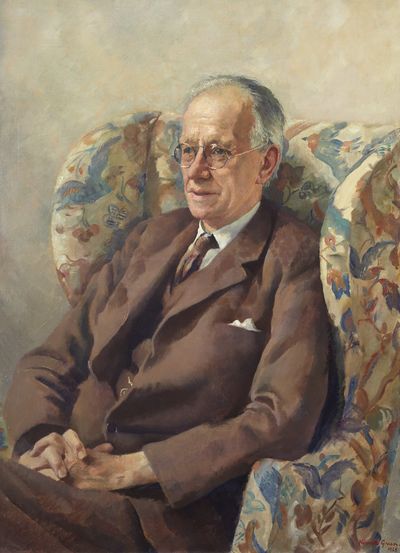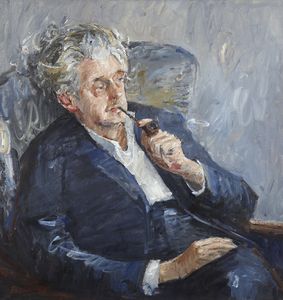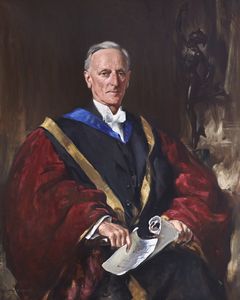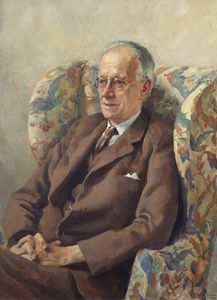Rectorial Election, 1936
The Rectorial Election of 1936 was the first to be won by neither a military or political figure. The successful candidate was Sir Herbert Grierson (1866-1960), recently retired Professor of Rhetoric and English Literature.
Previous Elections
From the reconstitution of the office of Rector in 1859 through to 1929, elections were fought on party-political lines. The University's Conservative and Liberal Clubs would each propose a candidate, generally a career politician. In 1932, however, the political clubs signed a joint declaration that they would no longer put forward candidates. It was widely felt that a succession of absentee Rectors had treated the post as largely ceremonial, and that the University required a politically independent working Rector with the necessary time to devote to his duties. The first 'non-political' election had resulted in the election of General Sir Ian Hamilton (1853-1947). Despite fears that the students had yet again elected an distant Establishment figure, Hamilton proved to be one of the University's most active and engaged Rectors. When his term was completed in 1935, students again elected a military man, Field Marshal Edmund Henry Hynman Allenby, 1st Viscount Allenby (1861-1936). Allenby, however, died suddenly a month after his installation, and a new election was called in 1936.
1936 Election
This time, students were offered a choice of five candidates:
- Sir Herbert Grierson - Knight Professor of Rhetoric and English Literature from 1915 to 1935
- Hugh MacDiarmid (1892-1978) (pseudonym of Christopher Murray Grieve) - poet, Scottish nationalist, and leader of the Scottish Literary Renaissance movement
- Sir John Donald Pollock (1868-1962) - a major benefactor of Edinburgh University who donated it the land on which Pollock Halls of Residence are built
- Edward Theodore Salvesen, Lord Salvesen (1857-1942) - former judge of the Court of Session
- Douglas Chalmers Watson (1870-1946) - former chief physician at Edinburgh Royal Infirmary and founder of the Patriotic Food League during the First World War
Grierson's supporters stressed his familiarity with university affairs, understanding of the needs and wishes of students, high standing with the university authorities, tactfulness, independent mind, and political neutrality. Grierson believed that the Universities (Scotland) Act 1889 had seriously damaged the independent tradition of Scottish universities. He believed that the introduction of an entrance examination and of specialized honours courses was at odd with the democratic, generalist that lay at the heart of Scottish education.
MacDiarmid and Watson had both previously stood in the 1935 election. In 1935, MacDiarmid's supporters had presented him as the leader of both an cultural and political left-wing nationalist movement. He was promoted as heir to the Scottish radical tradition, working towards the liberation of the Scottish masses. There had perhaps been too little emphasis on how specifically he planned to serve Edinburgh University as Rector, and he had been the first candidate to be eliminated under the new single transferable vote system. This time round, his supporters' campaign (largely coordinated by George Elder Davie (1912–2007)) was more focused on University issues. MacDiarmid, they argued, would be the ideal man to lead a national movement for increased grants for the Scottish universities.
Douglas Chalmers Watson was an expert on nutrition, widely respected for his work bolstering the national food during the First World War, when a submarine blockade interrupted imports. He had the backing of most medical students.
Sir Donald Pollock's campaign centred on his scheme for student hostels or halls of residence. This was fiercely opposed by MacDiarmid's supporters who believed that 'hostelisation' would isolate students from the rest of the population of Edinburgh. Instead, they advocated the creation of a new student's union.
The 79-year-old Lord Salvesen's campaign unwisely stressed his work for an extension to Edinburgh Zoo and chairmanship of the Scottish Public House Reform League. Students were unpersuaded that he was able to engage with the issues that most directly concerned them.
The single transferable vote system meant that on the first count, the two lowest polling candidates would be eliminated, and their votes redistributed among the remaining candidates. Sir Donald Pollock topped the first count with 795 votes, and MacDiarmid and Salvesen were eliminated with 266 and 134 votes respectively. Redistribution of votes gave Pollock 838 votes, Grierson 864, and Watson 696. This meant that Watson was now eliminated and his votes redistributed. As most of Watson's supporters had backed Grierson as their second choice, the final result was a comfortable victory for Grierson, polling 1329 votes to Pollock's 960. Pollock would subsequently win the Rectorial Elections of 1939 and 1942 and stand unsuccessfully for a third term in 1945.
Gallery
Hugh MacDiarmid (1892-1978), portrait by John Caldwell Brown
Sir John Donald Pollock (1868-1962), portrait by Stanley Cursiter
Sir Herbert John Clifford Grierson (1866-1960), portrait by Kenneth Green
Related Pages
- Separation of Roles of Principal and Professor of Divinity, 1620
- Transfer of Rectorship to Lord Provost of Edinburgh, 1665
- Universities (Scotland) Act 1858
- First Election of Rector by Student Body, 1859
- Election of Lord Kitchener as Rector, 1914
- First 'Non-Political' Rectorial Election, 1932
- First Celebrity Rector, 1948
- Election of Sir Alexander Fleming as Rector, 1951
- Resignation of Rector Malcolm Muggeridge, 1968
- Election of Gordon Brown as Rector, 1972
- First Woman Rector, 1988
Other University Events in 1936
Sources
- Donald Wintersgill, The Rectors of the University of Edinburgh 1859-2000 (Edinburgh: Dunedin Academic Press, 2005)



